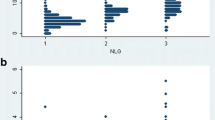Abstract
Although nerve conduction study (NCS) is the method most frequently used in daily clinical practice to confirm clinical diagnosis of Carpal tunnel syndrome (CTS), ultrasonographic (US) measurement of the median nerve cross-sectional area is both sensitive and specific for the diagnosis of CTS. Moreover, an algorithm evaluating CTS severity based on CSA of median nerve was suggested. This study is aimed to investigate the clinical usefulness of this algorithm in assessing CTS severity. The patients underwent a full clinical examination, including Tinel and Phalen test, and questioned about symptoms and the secondary causes of CTS. All of the patients refilled a Turkish version Levine Boston Carpal tunnel syndrome questionnaire (BQ) and the visual analog scale for pain (VAS 0–100 mm) A MyLab 70 US system (Esaote Biomedica, Genoa, Italy) equipped with a broadband 6–18 MHz linear transducer was used for US examination. The cross-sectional area of the median nerve was measured at the proximal inlet of the carpal tunnel (US cut-off points that discriminate between different grades of CTS severity as 10.0–13.0 mm2 for mild symptoms, 13.0–15.0 mm2 moderate symptoms and >15.0 mm2 for severe patients). Nerve conduction studies were carried out, and severity of electrophysiological CTS impairment was reported as normal, mild, moderate, severe and extreme. The agreement between NCS and US in showing CTS severity (normal, mild, moderate and severe) was calculated with Cohen’s κ coefficient. Ninety-nine wrists of 54 patients (male/female: 4/50) were included in the study. Mean ages of patients were (±SD) 43.3 ± 11 years. Forty-nine patients had idiopathic CTS, whereas five had secondary CTS (4 had diabetes mellitus and 1 had hypothyroidism). Symptoms were bilateral in 45 patients (83.3%). There were statistical differences between the groups according to electrophysiologic severity scale in terms of age (P < 0.001), body-mass index (P = 0.034), VAS (P = 0.014), Boston symptom severity (P = 0.013) and CSA of median nerve (P < 0.001). The identification of CTS severity showed substantial agreement (Cohen’s κ coefficient = 0.619) between the US and NCS. Also the four groups based on US CTS severity classification were significantly different in VAS (P = 0.017) and Boston symptom severity (P = 0.021). The median nerve swelling detected by calculation of the CSA reflects in itself the degree of nerve damage as expressed by the clinical picture. In addition to CTS diagnosis, sonographic measurement of CSA could also give additional information about severity of median nerve involvement. Using of US may cost-effectively reduce the number of NCS in patients with suspected CTS.

Similar content being viewed by others
References
Viera AJ (2003) Management of carpal tunnel syndrome. Am Fam Physician 68(2):265–272
Ziswiler HR et al (2005) Diagnostic value of sonography in patients with suspected carpal tunnel syndrome: a prospective study. Arthritis Rheum 52(1):304–311
Filippucci E et al (2006) Ultrasound imaging for the rheumatologist. II. Ultrasonography of the hand and wrist. Clin Exp Rheumatol 24(2):118–122
Wong SM et al (2002) Discriminatory sonographic criteria for the diagnosis of carpal tunnel syndrome. Arthritis Rheum 46(7):1914–1921
El Miedany YM, Aty SA, Ashour S (2004) Ultrasonography versus nerve conduction study in patients with carpal tunnel syndrome: substantive or complementary tests? Rheumatology (Oxford) 43(7):887–895
Levine DW et al (1993) A self-administered questionnaire for the assessment of severity of symptoms and functional status in carpal tunnel syndrome. J Bone Joint Surg Am 75(11):1585–1592
Sezgin M et al (2006) Assessment of symptom severity and functional status in patients with carpal tunnel syndrome: reliability and functionality of the Turkish version of the Boston Questionnaire. Disabil Rehabil 28(20):1281–1285
Jablecki CK et al (1993) Literature review of the usefulness of nerve conduction studies and electromyography for the evaluation of patients with carpal tunnel syndrome. AAEM Quality Assurance Committee. Muscle Nerve 16(12):1392–1414
Padua L et al (1997) Neurophysiological classification and sensitivity in 500 carpal tunnel syndrome hands. Acta Neurol Scand 96(4):211–217
Lee CH et al (2005) Correlation of high-resolution ultrasonographic findings with the clinical symptoms and electrodiagnostic data in carpal tunnel syndrome. Ann Plast Surg 54(1):20–23
Bayrak IK et al (2007) Ultrasonography in carpal tunnel syndrome: comparison with electrophysiological stage and motor unit number estimate. Muscle Nerve 35(3):344–348
Padua L et al (2008) Carpal tunnel syndrome: ultrasound, neurophysiology, clinical and patient-oriented assessment. Clin Neurophysiol 119(9):2064–2069
Schmelzer RE, Della Rocca GJ, Caplin DA (2006) Endoscopic carpal tunnel release: a review of 753 cases in 486 patients. Plast Reconstr Surg 117(1):177–185
Mondelli M et al (2008) Diagnostic utility of ultrasonography versus nerve conduction studies in mild carpal tunnel syndrome. Arthritis Rheum 59(3):357–366
Author information
Authors and Affiliations
Corresponding author
Rights and permissions
About this article
Cite this article
Karadağ, Y.S., Karadağ, Ö., Çiçekli, E. et al. Severity of Carpal tunnel syndrome assessed with high frequency ultrasonography. Rheumatol Int 30, 761–765 (2010). https://doi.org/10.1007/s00296-009-1061-x
Received:
Accepted:
Published:
Issue Date:
DOI: https://doi.org/10.1007/s00296-009-1061-x




